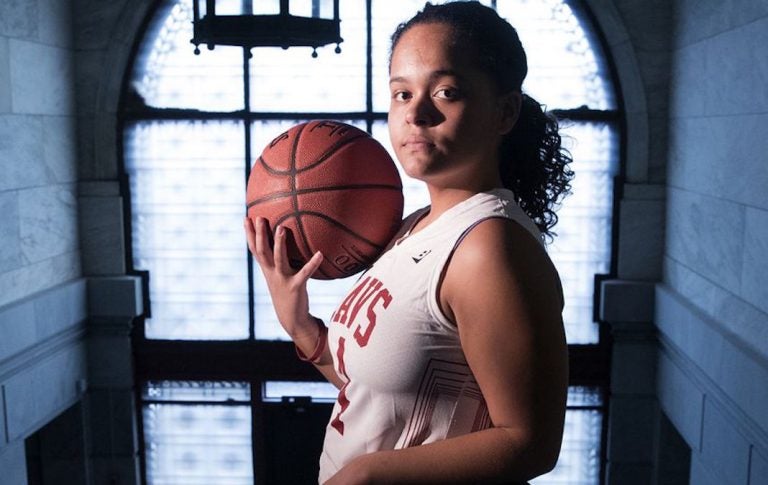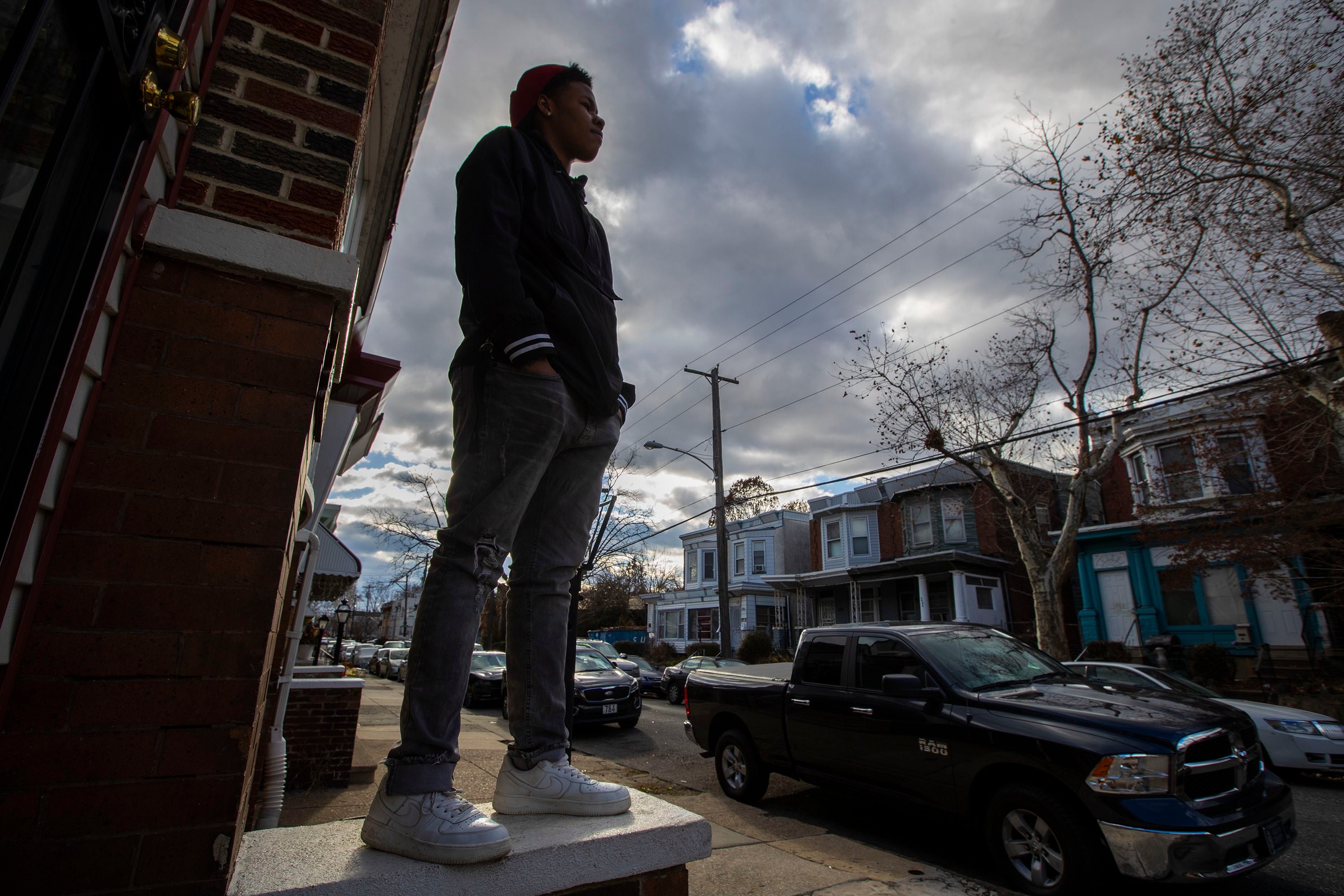Sports fueled Philly athletes Dajah Horsey and Malika Douglas in their fight against food insecurity
Philly athletes Dajah Horsey and Malika Douglas show how athletics help girls fight back against food insecurity.

Philly athletes Dajah Horsey and Malika Douglas show how athletics help girls fight back against food insecurity. (Charles Fox/The Philadelphia Inquirer)
This article originally appeared on The Philadelphia Inquirer.
_
Part two of the Inquirer’s “Hunger Games” series.
Dajah Horsey grew up in a hurry. The pace was too fast. Drug addiction and incarceration, she felt, made many of the adults in her life unreliable.
In middle school, junior high, and high school, Horsey — now an 18-year-old senior on the Girard College girls’ high school basketball team — often struggled to feed herself, her younger siblings, and younger cousins.
Their hungry mouths sometimes met her at the front door while adults nodded off nearby, cigarettes dangling precariously within their fingertips as they drifted into drug-induced stupors.
The memory still makes her voice quake. The weight of responsibility nearly made her spirit break.
But high school basketball became her outlet, a refuge that introduced people who provided stability within the nomadic, sometimes “homeless” life she endured.
The complicated, tentacled consequences of food insecurity faced by girls while competing in high school sports in and around Philadelphia can have various life-altering effects that researchers and relatives, care takers and coaches, athletes and advocates have battled for years.
The federal government defines food insecurity as “lacking consistent access to enough food to live an active, healthy life.”
According to the most recent federal report, 37.2 million people – including 11 million children nationally – were affected in 2018. Horsey has been one of those children for years. But those who know her say her childhood ended long ago.
“I have a lot of drug addicts in my family,” she says, “people who were in and out of jail. Barely anybody from my family ever graduated from high school.”
The 5-foot-3 power forward won’t play basketball in college. Universities covet her brains instead. That was always her plan.
“I promised myself I’m gonna go to school,” she says, “finish school, and be somebody.”

‘Making me feel like somebody’
Malika Douglas, now 23, remembers the fat jokes when she was a kid. It was hard enough, she says, living in homeless shelters with her mom and two younger siblings. She played sports as a teenager to shed the weight that made her a target for bullies.
Douglas says she rarely missed meals as a child because her mom always provided something, “even if she had to skip meals herself.” Research suggests, though, that being overweight could be a potential consequence of food insecurity.
Bullies, Douglas says, were definitely a consequence of being overweight.
The physical, social, and academic benefits reaped by girls who compete in sports are known widely throughout the scientific community. Various studies have noted improvements in cardiovascular and bone health, healthy menstrual function, decreased risks of chronic disease and obesity, and more. Girls who play sports are also associated with the ability to form strong social bonds, decreases in truancy, and increases in academic performance.
About 40 percent of teenage girls, though, do not actively participate in sports, according to the Women’s Sports Foundation’s 2018 Teen Sport Report. From 2018 to 2019, more than a million more boys than girls participated in high school sports, which saw an overall decrease in participation for the first time in 30 years.
Research trends also suggest the participation gap between boys and girls could persist, which also could indirectly influence the ability of girls to tighten the gender wage gap.
Data shows dips in girls sports participation, says Nicole LaVoi, Director of the Tucker Center for Research on Girls & Women in Sport at the University of Minnesota.
National Survey of Children’s Health data shows that only 24 percent of children aged 6 to 17 engage in the Centers for Disease Control and Prevention’s recommenced 60 minutes of physical activity per day, according to the Aspen Institute’s most recent State of Play report. That represents a decline from the 30 percent reported a decade earlier. Boys [28 percent] are also more likely than girls [20 percent] to meet that same daily physical activity recommendation.
Decrease in Participation Across the Board
The number of children ages 6 to 12 who played a sport on a regular basis decreased across all income levels and demographics but one from 2012 to 2018.

Girls, LaVoi said, also participate in sports less as they get older. The declines, she said, are more obvious and steep for specific girls: girls of color, LGBTQ girls, low socioeconomic state girls, immigrants girls, and girls with cognitive and developmental disabilities.
Participation, however, guarantees nothing.
A safe, healthy, and supportive environment is also key, according to the Tucker Center’s 2018 Developing Physically Active Girls evidence-based research report.
Douglas can attest. Sports might have saved her life.
She started with basketball at 12 and continued with cross country, soccer, and swimming.
Damien Abrams, now 37, was her middle school basketball coach at Mastery Charter’s Pickett campus in Germantown. He remembers Douglas as “a girl who was bigger than everybody else, and played like it, but wasn’t that skilled yet.”

The environment Abrams created, Douglas says, helped her cope when difficult circumstances arose at home.
“When coach Damien started to give me that energy, making me feel like somebody, I kinda felt better,” Douglas says. “My household situation was rarely in my head because I was always on the court or in the gym lifting weights.”
She was in high school at Mastery Charter North when she told her mom she no longer wanted to struggle in shelters. When Douglas told Abrams — who was also her high school basketball coach — he opened his home, replete with a surrogate family that included his wife and children.
“Honestly, if I wouldn’t have met coach Damien,” Douglas says, “I feel like I woulda been in a world full of trouble. I feel like I’d be out here locked up, or probably be dead, to be honest.”
Douglas moved into the Abrams household during the summer before her junior year.
Abrams’ wife, Samech [Sa-meech], welcomed Douglas as a member of the family. The couple’s three children also took to her quickly. Their youngest, Khary, now 12, fell especially hard for Douglas, who shared his love of basketball.
When Douglas’ junior season began, Samech, now 42, even went to games with a T-shirt that bore Douglas’ name and jersey number, 23.
“I went to games before,” Samech says, “but once she became a part of our family, it was like, ‘No, I’m there because I’m supporting you.’ So I’m really out there shouting your name, shouting your number.”
When her children needed clothes, Samech also shopped for Douglas. They celebrated her September birthday, bought her a cell phone, a bed, and set up her own bedroom. They also provided stability, rules, and structure, made sure she got to school on time, and finished homework. The school was made aware of the arrangement before it occurred, an official confirmed.
“They really made me feel like family,” Douglas says. “It was a family.”
“They showed me things I always wanted when I was a kid,” she says, “like my family being at every game, wearing my jersey, showing me that I’m doing this for somebody and not just myself. I don’t mind just doing it for myself, but I also want to know that I’m not by myself…and even to this day they still let me know that I’m not by myself.”
‘More than the fridge is empty’
Dajah Horsey got her first job at 12. She didn’t have time to play games.
According the Aspen Institute’s most recent State of Play Report, 33 percent of children [6 to 12] in households with average incomes less than $25,000, participated in no sports in 2018. In contrast, only 10 percent from households with average incomes of $100,000 participated in no sports.
In 2018, full-time wage and salary women made 81 percent of the median of full-time wage and salary men, according to a U.S. Bureau of Labor Statistics report in March.
Women also had lower median weekly earnings than men in most occupations for which the report had data on men and women. Women who identified as American Indian, Alaska Native, Black and Hispanic also earn 26 percent less than White men, according to 2019 PayScale report.
Girls who play sports, however, could be less likely victims of the gender wage gap, says LaVoi, who referenced two pieces of data.
Ernst & Young surveyed more than 800 high-level women executives and found 90 percent played sports at some point in life, according to a series of EY surveys. Among women in C-suite positions [CEO, CFO, CIO, etc], that number rose to 96 percent. Research, LaVoi says, also suggests girls who play high school sports are more likely to achieve in “high-paying, male-dominated positions” in the workforce.
If sport benefits girls in various ways, working instead to feed younger siblings, younger cousins, and yourself, could leave little time and energy for participation.
Louise Ivers, executive director of the Massachusetts General Hospital Center for Global Health, says there is evidence that suggests teenagers in food insecure households must sometimes generate income.
At 12, Horsey passed out fliers for a business near her home in Kensington, she says, for about $2 per hour. At 14 – Pennsylvania’s legal working age – she worked at McDonald’s. By 15, she had two jobs. She currently has two jobs.
Eventually, the stress became too much. She isolated herself from friends. She stopped eating. Stress consumed her.
Court records show both of her parents were arrested multiple times. She also witnessed her mother endure physical abuse from multiple romantic partners. Adults in her home, Horsey says, also sometimes sold food stamps to get drugs.
“That part got to me the most,” she said, voice momentarily quivering with emotion. “So I was real good at managing my money and saving it, making it last, because I knew, ‘I’m not gonna have food tomorrow if I don’t save this money.’ I would go to the store and get like a cheesesteak platter or something and come back and all my cousins would surround me coming in the door because they were hungry.”
A literature review published in 2011 showed stress, anxiety, and depressive-related associations between food insecurity and women of child-bearing age.
“What many people under-appreciate is that food insecurity can create a very high mental health burden,” Ivers said in a phone interview. “I think it gets at the idea that food insecurity is not as simple as saying, ‘the fridge is empty.’ It’s much more complicated than that.”
Horsey struggled early at Girard College, currently a five-day boarding school for first- through 12th-grade students from low-income families. She entered as a freshman. Other girls, she felt, already had forged bonds.
Her life at home had also taken a toll. About a year earlier, she asked her maternal grandmother, Eileen Dangler, to send her to a mental health professional.
“Dajah took care of herself because her parents were ultimately of no use to her,” Dangler said in a phone interview.
“I couldn’t handle what she handled,” Dangler, 63, added later. “If it was me, I would have been a mess.”
The mental health professional suggested that Horsey find something she could do just for herself.

Keith Ford, a counselor at Russell H. Conwell Middle Magnet School in Kensington, where Horsey attended, suggested basketball. He also told Horsey about Girard College, and later contacted Chelse Hall, then the Girard College girls’ basketball coach, and asked Hall to look after Horsey. Hall, whose Right Turn Youth Academy helps young people through basketball, became a mentor to Horsey.
“I found out basketball was the thing I could do for myself,” Horsey says. “I used it as a stress reliever.”
Overweight as a condition of food insecurity
Malika Douglas injured both of her knees playing high school basketball at Mastery North Charter. The ligament damage in her left knee happened in a scrimmage during her junior season.
Healthy eating was already important in the home of her coach, Damien Abrams. Still, Douglas didn’t want to gain the weight she worked so hard to lose. If she did, Abrams and his wife made sure it wasn’t because of her diet. Douglas sometimes took pictures of the unfamiliar food prepared in the Abrams household.
“Just because I didn’t see much of that growing up,” Douglas says. “Salads with fruit and stuff like that.”
Research shows poverty and low income are associated with food insecurity, but even adequate household income doesn’t always prevent its consequences. Anti-hunger organizations such as Philabundance note that unexpected costs also send those living above the poverty line in search of assistance.
Research reviewed by Ivers, the professor at Harvard, shows various coping strategies, including eating less expensive, more readily available foods, can occur when access to food is limited or uncertain.
Food deserts (neighborhoods that lack healthy food sources) and food swamps (areas with an abundance of unhealthy food sources) can be contributing factors.
As a result, an overweight person who doesn’t miss many meals still can suffer the consequences of food insecurity. In fact, in some cases, weight can be a consequence.
“If you look at food insecure people in many parts of sub-Saharan Africa or in Haiti, where I also work, they’re often underweight,” Ivers said. “But often what we find here in the U.S. is food insecurity associated with overweight, actually.”
Melinda Manore has spent much of her life teaching young people the importance of health, nutrition, and the benefits of physical activity. She has been a professor at Oregon State University since 2001, but soon will have taught in six different decades, beginning with 1973, when she was certified in elementary and secondary education.
Manore, a registered dietitian and board-certified specialist in sports dietetics, has also used athletics to teach young people how proper nutrition can improve their performance and their long-term health.
The WAVE Sport Nutrition Curriculum she helped develop “uses youth’s interest in sports to teach them about healthy eating and hydration to fuel a healthy, active body for life.”
The curriculum was pilot-tested with high school soccer players through a U.S. Department of Agriculture grant. It is also free to download, Manore explained in a phone interview, and is applicable to all active adolescents, and can be adapted for youths in various sports.
The curriculum was born from a two-year intervention during a 2018 study of high school soccer players who were 64 percent female and predominantly Latino. Forty-six percent were also enrolled in the National School Lunch Program, which was used as an indicator of socioeconomic status, Manore said, not necessarily of food insecurity.
Researchers taught nutrition facts, but also how to cook, when to eat meals around practice and games, and how to shop on a budget during field trips to stores, among other things.
“What we really need to do is take this into the schools,” Manore said, “and not just for the athletes . . . you want to engage them all.”

‘I already knew they would always follow me’
Malika Douglas never graduated from Mastery North. She moved back in with her mother just before her senior year began.
Douglas had met a girl and fell in love. The Abrams’ household rules, which once provided structure, grew at odds with her heart. She wanted to stay out late and “be a kid,” she says.
So she moved in with her mother in West Philly, which was closer to her then-girlfriend.
But it was also farther from Mastery North. Her commute on public transportation, she says, took at least an hour. She also injured her right knee during that basketball season.
“I was so discouraged about not playing that I started to fail my classes,” she says.
She was also late to school several times and eventually stopped going. Abrams and his wife worried about what would become of the girl they grew to love. Abrams worked in patient registration at an area hospital when he learned about JEVS Human Services, a nonprofit that helps, among others, those facing “adverse socioeconomic conditions including unemployment and underemployment.”
He informed Douglas. Even after she started one of the programs, Abrams and his wife knew they could only hope she would finish.
Douglas graduated in June 2018. Abrams, now an assistant women’s basketball coach at Alvernia University, and his wife attended the ceremony.
“It meant a lot,” Douglas says, “but I already knew they would always follow me.”

‘She did it with grace’
In her profession, Kathy Jretah (Dra-ta), a social worker at Girard College, worries that the word “resilience” might suggest Dajah Horsey has “got it all covered” and no longer will struggle.
Thanks in part to Jretah, the McKinney-Vento Homeless Assistance Act can help Horsey and others should they struggle. The federal law is designed to “address the needs of homeless children and youths and ensure educational rights and protections for these children.”
Horsey bounced from house to house, from relative to relative, throughout high school. She even stayed with family in New Jersey.
Sometimes those situations provided stability. At other times, she felt uncomfortable, restricting her food intake in hopes she wouldn’t be asked to leave households that were already feeding children.
Her off-campus jobs also meant Horsey wasn’t always around when Girard served meals.
Child welfare agencies from Pennsylvania and New Jersey, Jretah said in a phone interview, have been involved with Horsey, her siblings, and a few of their households.

Ultimately, however, Horsey was not officially placed into those systems. Last year, Jretah, the McKinney Vento liaison at Girard College, certified that Horsey, who is deemed homeless and/or unaccompanied, qualified for McKinney-Vento designation.
The process, Jretah says, required Horsey to demonstrate, among other things, how she would care for herself through a checklist of tasks, goals, and plans.
“She did it with the grace of an adult,” said Jretah, a Girard College social worker for nearly 26 years.
“She is a real-life superhero,” Jrateh added later. “With the weight of her family, the weight of her siblings on her back, being a female, the weight of growing up poor, she’s made some incredible things happen in her life. Why look up to Superman when you have a Dajah Horsey right here?”
The McKinney-Vento designation also allows Horsey to file as independent for federal and state student college aid, which makes more resources available.
So far, Horsey has been accepted to several universities, including La Salle, Jefferson, Neumann, Indiana University of Pennsylvania, and Arcadia. Some, she says, have offered full residential scholarships, academic scholarships, study-abroad programs, and more.
“It’s like I have to do good for myself, but I’m the oldest of six siblings,” she says. “So I have a lot of people looking up to me. [My siblings] are really what kept me going. If not for them, I probably would have given up.”
That pressure – and the life circumstances that caused it – have taken a toll, but Horsey says, “it made me stronger. It made me who I am today.”

__________________________________________________________________________________________________________________________________
The Inquirer’s investigative reporting is supported in part by The Lenfest Institute’s Investigative News Fund. Editorial content is created independently of the Fund’s donors. A listing of Lenfest Institute donors can be found at lenfestinstitute.org. Gifts to support the Investigative News Fund can be made at www.inquirer.com/donate.
The Philadelphia Inquirer is one of 21 news organizations producing Broke in Philly, a collaborative reporting project on solutions to poverty and the city’s push toward economic justice. See all of our reporting at brokeinphilly.org.
 RESOLVE PHILADELPHIA
RESOLVE PHILADELPHIA
WHYY is your source for fact-based, in-depth journalism and information. As a nonprofit organization, we rely on financial support from readers like you. Please give today.




